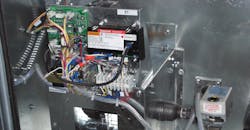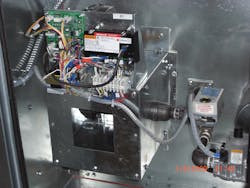What Happened to My Burner Turndown?
By JIM JAGERS, Mestex, a division of Mestek Inc., Dallas TX
"What happened to my burner turndown?” is a question often heard when heating equipment delivers more heat than expected. To be able to answer that question, an engineer, a contractor, or a commissioning agent must first understand the meaning of turndown and how it is measured. Simply put, turndown, as it relates to burners, is the ratio of high fire to low fire. It can be expressed as the ratio of British-thermal-unit- (Btu-) input or Btu-output rate or as the ratio of output temperature at high fire to output temperature at low fire. The greater the turndown, the better the temperature control.
Power burners, used in indirect-fired heaters and boilers, have ratings of 2:1 to 100:1, meaning their Btu input or output at high fire is two times (2:1 turndown) to 100 times (100:1 turndown) that at low fire. Direct-fired burners often have ratings of 25:1 or 30:1, meaning their high-fire rating is 25 to 30 times higher than their low-fire rating.
Burner manufacturers test their burners in laboratories, where they can adjust fuel/air ratio for the best mix. Burner profiles can be arranged for ideal airflow across the burner, while burner velocity can be tweaked to perfection. Burners are fired in an air-tunnel-like setting that provides even airflow undisturbed by fan turbulence. Like direct-fired burners, power burners are laboratory-tested to attain optimum turndown. Regardless of burner type, rarely can laboratory conditions be duplicated when a burner is placed into service. Air turbulence and high air velocity significantly affect turndown, especially at low fire. When airflow is not ideal, more fuel may be required to light a burner and/or keep it lit. Consider a flame in the face of wind: The flame of a burning match will easily be extinguished, whereas a larger flame will stay lit.
Heater manufacturers face design constraints that affect burner performance. To create a direct-fired heater with low air turbulence and perfect airflow, a manufacturer would have to design a very large—and expensive—unit. What’s more, ideal fuel-to-air mix is difficult to attain and partially reliant on the control system. Thus, it is evident turndown is related in part to heater design.
Another factor limiting turndown is the burner itself. Typically, a minimum input of fuel is required to keep a burner from “flaming out.” This is similar to an automobile: If gasoline intake were reduced while a vehicle was idling, the engine would stall.
Burners utilizing intermittent pilot control have a lower turndown than those utilizing interrupted pilot control. Unlike an interrupted pilot, which turns off once the main burner is lit, an intermittent pilot remains on when the main burner is on, adding a constant amount of fuel to the flame and increasing the minimum firing rate accordingly. The lower the high-fire input rate, the greater the effect an intermittent pilot will have on turndown because turndown is a greater percentage of total fuel input.
Engineering the Firing Rate
The greatest contributor to reduced turndown is directly related to the firing rate specified by the engineer. Typically, an engineer will specify a Btu capacity or temperature rise for a heater or boiler. Recalling that a burner’s rated turndown is determined by measuring the ratio of high-fire Btu to low-fire Btu, it follows that the greatest turndown will be achieved when a burner is fired at its full input. That rarely is the case in field operation, however. For example, suppose a direct-fired heater has a design maximum firing rate of 650,000-Btu input per foot of burner and utilizes a burner with an ideal turndown of 25:1. At the very least, the burner would fire at 26,000 Btu per foot. The burner is available in 6-in. sections, with each section capable of 325,000 Btu. Thus, a 1-MBtu heater will require 3.08 sections (1,000,000/325,000). To ensure 1 MBtu is available, four 6-in. sections, or 2 ft of burner, must be used. In other words, the burner is oversized and must be underfired to operate at 1 MBtu.
Two feet of burner has a maximum rated input of 1.3 MBtu and a minimum rated input of 52,000 Btu (1,300,000/25). Bear in mind low-fire input does not change with a reduction in high fire. Thus, this heater would have a maximum turndown of 1,000,000:52,640, or 19.2:1. This represents a 23.2-percent reduction in possible turndown from the theoretically obtainable 25:1 maximum turndown. Stated another way, to reach the engineer’s specified maximum Btu-per-hour input, the burner will have 23 percent excess, or unused, capacity. Because of other typical heater-design constraints, another 2- to 5-percent reduction in turndown could be expected. Under certain conditions, a direct-fired heater could have an actual turndown as low as 4:1 with a fully modulating burner.
Unlike direct-fired burners, which can be built to size, power burners are available in a finite number of sizes. One power-burner manufacturer, for example, offers 21 standard power burners with turndowns rated from 2.5:1 to 12:1 in its catalog. Each has a specified maximum Btu capacity. Because of the finite number of power burners, an indirect-fired-heater or boiler manufacturer is forced to use the burner most closely matching its unit’s heating capacity. One burner manufacturer offers a burner with a maximum input rating of 3 MBtuh; the next-largest burner it offers is rated for 4.75 MBtuh. Each burner has a rated turndown of 5:1. Thus, the 4.75-MBtuh burner has a minimum output of 950,000 Btuh.
Several indirect-fired-heater and boiler manufacturers have units with input ratings of 3.125 MBtuh and 4.375 MBtuh. With these two input capacities, the 4.75-MBtuh burner must be utilized. That means the smaller appliance has a burner with 52 percent excess capacity and an appliance turndown of 3.29:1 (3,125,000/950,000). The larger has over 8 percent excess capacity and a heater turndown of 4.5:1 (4,375,000/950,000).
One power-burner manufacturer claims its burners have a maximum turndown approaching 60:1. Comparing the ratings of this manufacturer’s burners to those of other manufacturers’ is like comparing apples to oranges, however. While they all are power burners, they are rated quite differently. Earlier, it was said turndown is independent of other burner ratings. Some power-burner manufacturers prefer to be conservative with their ratings because of their target markets. Manufacturer A, for example, supplies a great many burners to the air-heating industry, which has standards requiring a burner to operate at or below certain emission levels. Thus, Manufacturer A has chosen to rate its burner’s turndown based on these limits. It claims its burner has a stated turndown and its fuel/air mix is “on ratio” throughout its operational range. Essentially, this means the burner fires cleanly between high fire and low fire. Manufacturer B, however, focuses principally on the industrial-process market, which values turndown over cleanliness; thus, Manufacturer B rates its burner with a much higher turndown. This turndown would be in the range of Manufacturer A’s turndown, if the burner were fired on ratio.
There are power burners with very high turndown rates. Typically, these burners are designed with special fans, valves, and control systems that precisely govern operation. These burners also may be equipped with sensitive temperature and combustion sensors. For normal comfort-heating applications, this type of control and turndown is overkill and cost-prohibitive.
Appliance and burner manufacturers like to display their products’ best attributes. Without an understanding of the basis of their claims, confusion and misinterpretation are likely to occur. A 25:1 burner turndown regularly is required in direct-fired-heater specifications. As this discussion has demonstrated, while it is easy to establish the burner turndown, there are a number of factors that determine heater turndown.
Now in his 25th year with Mestex, the author is the firm's national sales manager. Jagers also is actively involved with numerous testing and certification agencies, writing safety and design standards for the HVAC industry.

